Bringing a dog into your life is an exciting decision, and selecting the right breed is essential for a happy and harmonious relationship with your new furry friend. With so many breeds available, it’s important to choose one that fits your home and lifestyle. From personality traits to potential health concerns, here’s everything you need to know about choosing a dog breed.
What breed is right for my living situation?

Where you live plays a significant role in determining which breed will thrive in your home. If you live in an apartment, a breed that’s adaptable to confined spaces may be a better fit. Smaller breeds like Cavaliers, French Bulldogs, or Dachshunds are often well-suited to apartment living due to their manageable size and lower exercise needs.
If you have a large backyard or access to outdoor space, larger breeds such as Labrador Retrievers, Golden Retrievers, or Border Collies may be a good fit. These dogs often need more space to run and play, and a large yard will help keep them physically and mentally stimulated.
Additionally, consider the dog’s noise levels. Some breeds, like Beagles or Huskies, are known for being vocal, which might be a concern in shared living areas or apartments with close neighbours.
How to Match a Dog’s Energy Level with Your Lifestyle

Every dog has its own energy level, and choosing a breed that aligns with your lifestyle is essential for ensuring the happiness and health of you and your doggo. Some dogs are highly active and thrive on rigorous exercise, while others are more relaxed and content with a laid-back routine. Understanding the energy requirements of different breeds helps you find a dog that fits seamlessly into your life.
High-Energy Dogs
If you’re an active person who enjoys outdoor adventures like running, hiking, or biking, a high-energy breed might be the best fit for you. These dogs are full of energy and thrive on regular physical and mental stimulation. They excel when they have a job to do or ample space to burn off energy.
- Border Collie: Known for being one of the most intelligent and high-energy breeds, Border Collies love physical activities like running, fetch, and agility training. They need both physical exercise and mental stimulation to stay engaged, making them perfect companions for active individuals or families who enjoy outdoor activities.
- Australian Shepherd: Much like the Border Collie, the Australian Shepherd is another highly energetic breed that thrives on activity. These dogs are natural herders, and they require consistent mental and physical stimulation. They love outdoor activities such as hiking and running, and they do well in active households.
- Vizsla: This breed is known for its boundless energy and need for exercise. Vizslas are incredibly athletic and are often described as “velcro dogs” because they love to stay close to their owners. They need at least an hour of exercise every day, and they’re perfect for individuals who enjoy running, jogging, or any outdoor activities.
Low-Energy Dogs
If you lead a more relaxed lifestyle or have a busy schedule that doesn’t allow for long walks and vigorous exercise, a low-energy dog breed may be a better match. These breeds are typically more laid-back and can be content with moderate daily exercise and a comfortable routine.
- Basset Hound: Known for their calm nature, Basset Hounds are happy with shorter walks and plenty of lounging time. Their low-energy level makes them great companions for people who want a dog that doesn’t require constant activity. While they still need regular exercise to keep them healthy, they aren’t as demanding as high-energy breeds.
- Shih Tzu: These small dogs are affectionate and love being around their owners, but they don’t require excessive exercise. A few short walks a day and some playtime indoors are usually enough to keep them content. Shih Tzus are ideal for people with a more laid-back lifestyle or those living in smaller spaces like apartments.
- Bulldog: Bulldogs are known for their relaxed and easygoing personalities. They require only moderate exercise, such as short walks, and they enjoy lounging around the house. While they need some playtime and mental engagement, they are generally calm and content with low-impact activities. This makes them a great fit for individuals who prefer a more relaxed routine or have limited time for vigorous exercise.
While low-energy dogs may not require extensive physical exercise, it’s also important to remember that all dogs, regardless of their activity level, need mental stimulation. Providing regular enrichment activities, like puzzle toys, helps keep your dog’s mind engaged and prevents boredom.
Common Health Issues in Different Breeds

Health considerations are another key factor when choosing the right breed. Some dog breeds are more prone to specific health conditions, so it’s important to be aware of these issues before making a decision. While no dog breed is guaranteed to be free of health problems, understanding the potential risks can help you prepare for any future medical needs.
Larger breeds like Great Danes, Saint Bernards, and German Shepherds are more susceptible to joint issues, such as hip dysplasia, while breeds with short snouts, like Bulldogs and Pugs, often experience breathing difficulties due to brachycephalic syndrome. Additionally, certain breeds may be more prone to specific health conditions, such as skin allergies in Dalmatians or eye issues in Cocker Spaniels.
To help you make an informed decision, research common health issues in the breed you’re considering. It’s also a good idea to choose a reputable breeder who prioritises health and conducts health screenings on their breeding dogs to reduce the risk of inherited conditions.
Choosing the “right” dog breed
When it comes to choosing your dog, there is no right or wrong. While it’s always a great idea to choose a breed that aligns with your lifestyle, it’s also important to remember that training plays a crucial role in shaping your dog’s behavior and compatibility. For example, a so-called “good” breed without proper training can quickly become a handful, while breeds often labeled as “scary” — like Rottweilers, Bulldogs, and Mastiffs — can be some of the most loving, gentle companions when raised with the right guidance. Take the time to do your research, ask questions, and consider your preferences. By committing to consistent training, you can build a strong, lasting bond with your doggo.





